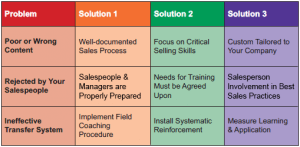Companies spend about $1 billion a year to deliver training to their salespeople. Ninety percent of that sales training fails to produce meaningful, long-term gains in performance. To my mind, that’s the same as saying the training fails, period.
The problem has three major causes, as shown in the graphic below. In the previous issue of this newsletter, I highlighted the first cause: wrong content. Simply put, most sales training programs try to teach the wrong things.

Now let’s look at the second major reason why so much training fails: It is rejected by salespeople.
You’ve seen them—the sales reps who come to a training session with the attitude that they already know it all: arms crossed, eyes rolling, virtually daring the instructor to say something that might interest them. These people were not properly prepared to come to your training. And without motivation, there can be no learning.
After all, what good is a sales training experience if the salespeople don’t buy into it? Most companies sadly underestimate the importance of preparing salespeople to receive training, as well as preparing their work environment to receive trained students.
Salespeople need to be sold on the need for training and the benefits it offers them. And I mean they have to be sold on the need for this particular training program – not on the idea of training in the abstract or on learning as a swell thing.
Here are just a few of the things you can do to properly prepare salespeople for training:
- Give them plenty of information about what the training will teach, why it matters to the company, and how it will help the learners, personally.
- Benchmark their current skills.
- Survey their perceptions of their own skills.
- Let them know that managers will hold them accountable for using the new skills on the job. And make sure that managers really do.
SALESPEOPLE MUST AGREE THAT THEY NEED THIS PARTICULAR TRAINING PROGRAM, NOT JUST ‘TRAINING’ IN THE ABSTRACT.
Selling salespeople on the need for training is no different from any other sale. The buyers (your salespeople) must see the program as a solution to needs that they agree exist. If they don’t recognize and agree on the need, the training will be a waste of time.
One more point about selling them on the need for training: Salespeople must perceive the benefits of using and mastering the skills the program teaches as far greater than the investment of time and effort required.
Finally, salespeople must have equity in what you are attempting to teach; they must have skin in the game. The best way to ensure that is to have them participate in developing the Best Sales Practices that your company intends to adopt. In the course of developing those best practices hand-in-hand with your experienced salespeople, you will also uncover valuable information such as:
- Your preferred sales process.
- Common milestones in that process, which are useful for setting good Commitment Objectives.
- Some of the Best Questions to ask customers in order to do things such as uncover needs, build rapport, and discover buying influences.
Salespeople and their managers must be sold on the training, and they must be prepared to execute and reinforce it in the field. Do not – do not – just lay the training on them and expect them to swallow it. That is a recipe for failure.
In the next issue, we will look at the third major cause of sales-training failure: ineffective transfer.
For information about how to make sales training pay huge dividends, contact Action Selling ® at (800) 232-3485.
Intrigued? For a fuller discussion of the key factors that determine whether sales training will succeed or fail, see our NEWLY REVISED white paper, 90% of All Sales Force Training Fails: Here’s the Problem – And the Solution.

